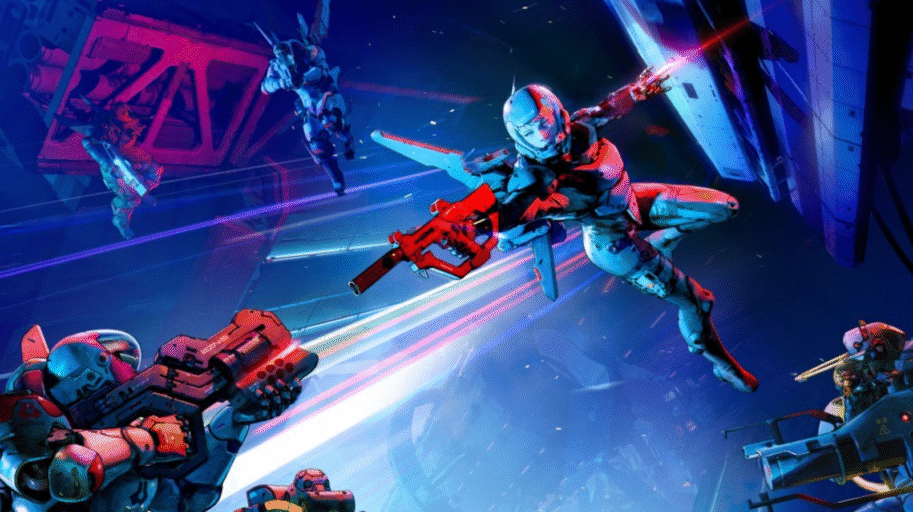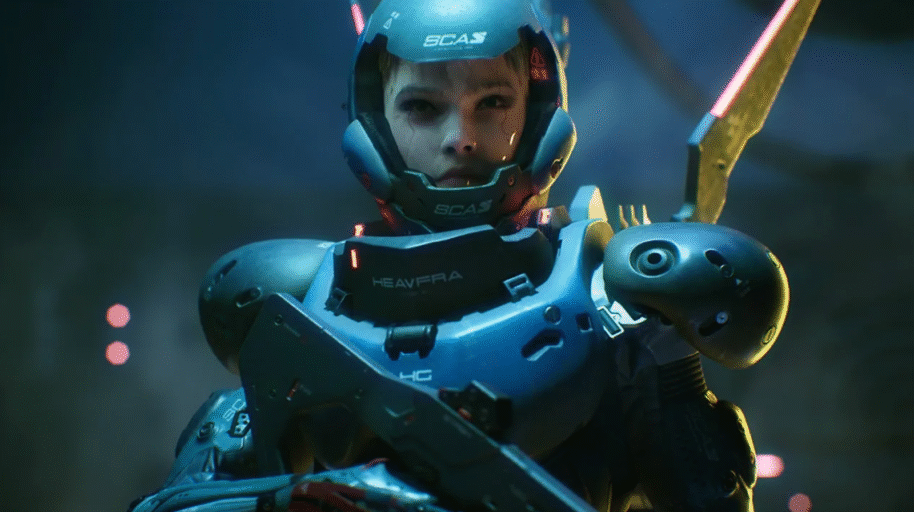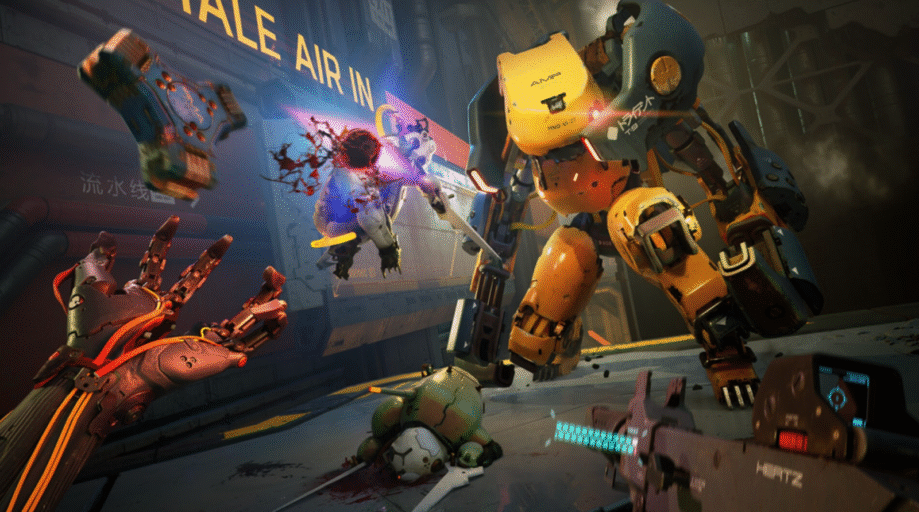Metal Eden: Review of an exciting arena shooter
Metal Eden has often been compared to DOOM Eternal, Ghostrunner, and Metroid. While it’s clear the developers drew inspiration from these games, they’ve added their own unique features. Back in 2017, they released the cyberpunk action game RUINER, which was well-received and left a lasting impression on many players.
Now, eight years later, they return with a new game in the same setting. This represents a clear step forward — we’re no longer looking at a niche top-down shooter, but something closer to DOOM in a cyberpunk world, which some players even prefer to the latest offerings from id Software.

The girl with wolf eyes
In general, it makes more sense to compare Metal Eden to DOOM Eternal rather than The Dark Ages. After all, the game from Reikon Games doesn’t fixate on close combat, dragons, or attempts to create a ‘Dark Souls with guns.’ It’s a pure arena shooter.
The story is also presented much more concisely. In the distant future, Earth has become uninhabitable, people’s consciousnesses have been digitised and placed into so-called cores, which are then sent into orbit around another planet, where the garden city of Möbius was built. However, the project’s creators, the Engineers, fell out with each other, and a rebellion by the AI followed.
In short, nothing good came of it — on the contrary, it resulted in a man-made disaster. It’s up to the beautiful android girl Aska to deal with the consequences and save the hive city and its inhabitants.
She’s impressive not only in appearance, but also in her detachable body, which allows her to mow down crowds of enemies, jump great distances, run on walls, and almost fly through the air. And if something goes wrong, she can be reassembled, with her arms and legs regenerating.
However, her mind and consciousness initially seem clouded — Aska is clearly under the influence of Nexus, one of the Engineers, who orders her to locate his colleagues and take their ‘higher cores’ to reach Möbius and save its inhabitants.
She salutes and sets off on another mission. Naturally, we quickly predict who the main villain will be, how it will all end, and at what point Aska will begin to have doubts.
One might think this is a reason to criticise the scriptwriters, especially given the sparse story presentation — there are few cutscenes (though very stylish), and many of Nexus’s monologues are passed over as we rush to the next mission. Aska is more talkative with other characters, but the essence remains the same.
Yet I hesitate to criticise the writing. For comparison, take Otherskin, where a girl and an AI on an alien planet have dull, banal dialogues about saving the universe.
In Metal Eden, the heroine’s interlocutors at least try to philosophise, joke, provoke, and intrigue. Some of the dialogue may be controversial, but it’s far better than meaningless platitudes. Acting is also key — Nexus’s voice immediately conveys a hidden threat, that of a paranoid philosopher with delusions of grandeur, angry at the world.
Even Aska’s silence, the way she reacts when confirming her status, and the blood running from her left eye reveal more about her character and the plot than any high-budget cutscene could.
For me, the main intrigue wasn’t the villain’s identity, but discovering who Aska truly is, uncovering the secrets of her past, and piecing together fragments of her memories — an intrigue that persists until the very end credits.
Players who enjoy uncovering hidden secrets and rewards in games like Metal Eden might also be interested in Hidden Jack, which offers a variety of surprises and bonuses for those seeking extra excitement.
The girl in the ball

For me, this is almost the perfect shooter — one that feels more focused on gameplay than plot, yet even the story is presented in a way that keeps you genuinely curious about certain questions right up until the finale. And I was quite satisfied with the answers.
Not to mention the gameplay itself. This is a stylish, fast-paced arena shooter that doesn’t just lock us into arenas — we’re periodically allowed to explore locations, uncover secret rooms, extra lives, and a special resource (dust) used for upgrading weapons. Sometimes this requires crawling into the darkest corners or finding hidden buttons.
In addition, Aska can occasionally transform into a ball, much like Samus Aran from Metroid. You may have heard that Mars rovers are being developed in a ball-shaped model, which many experts consider optimal. Well, in Metal Eden, it already works — and very effectively.
Transformed into an all-metal ball, we race across lava- or sand-covered surfaces, periodically shocking enemies with electricity, targeting them with missiles, and charging devices to open doors to the next level. Moreover, we can often switch between the girl and the ball on the fly, using whichever form is most suitable.
This looks especially impressive when switching between the ball and Aska mid-air during long jumps. Platforming is abundant here. Not only do we jump, but we also run along walls for extended periods, descend wires attached to air lifts, and use grappling hooks to swing between points to avoid falling or crashing.
When all of these mechanics — wall runs, grappling hooks, and extreme zip lines — come together, it’s a real thrill, evoking memories of DOOM Eternal. Overall, the platforming in Metal Eden is extremely satisfying, delivering an intoxicating sense of flow.
Heartfelt battles
This flow becomes even more captivating during arena battles. These can be fully enclosed spaces or narrow corridors, where it’s almost impossible to escape the monsters, or more open areas where you can run, shoot, and jump freely.
In those moments, I was reminded not of DOOM Eternal, but of Quake III: Arena — these levels feature trampolines that launch you into the air, making it incredibly fun to shoot at enemies mid-flight. Added to this are portals transporting you to other locations and walls you have to run along to collect ammunition, armour, and first aid kits.
Many of the more spacious locations are beautifully designed, and the combination of racing, shooting, and platforming is wildly exciting. Initially, it was difficult to get into the game and catch the rhythm — at high difficulty (and sometimes even at normal), surviving and winning was no easy feat.
Enemies attack not just in numbers, but with tactics — some charge at you directly, others shoot from a distance, and some cast nasty spells. Many even have armour that must be worn down with plasma, electric weapons, or a powerful strike.
We charge our strike when ripping cores out of enemies’ chests. This usually kills them instantly, but the brutal technique is only available under certain conditions, so you can’t just run around eliminating everyone.
This mechanic is an intriguing part of the combat system — levelling up allows you to enhance it and add new properties, such as causing an explosion that pierces enemy armour when a core is removed.
Even with these abilities, I struggled at first — perhaps because, at nearly 50, I hadn’t played such fast-paced shooters in a long time. As I got used to it and gained access to more powerful weapons, the game became easier, and I completed the entire second half on ‘hard’ mode.
I found my favourite guns, but that didn’t mean I abandoned the others — every weapon has its use. Even in the second half, after levelling up skills for extra ammunition drops, supplies were often scarce, and the pistol with unlimited bullets quickly overheated. I had to rely on the entire arsenal to survive.
Ask for levelling up

Many alternative modes for guns also proved useful — they are unlocked and levelled up in vending machines using the dust collected in the levels.
As a result, you can make the pistol fire homing missiles in alternate mode, the shotgun start firing a hail of homing shells, the submachine gun turn into a grenade launcher, and the stun gun fry enemies with fireballs or lightning bolts.
All of this can be further improved so that, for example, grenades leave a pool of napalm, and homing missiles explode when they hit a single target.
The levelling system in Metal Eden is quite competent — it opens up interesting possibilities beyond weapons. Somewhere in the middle of the game, I was surprised to discover that you can slow down time — this is one of the upgrades purchased with improvement points.
Among others are the aforementioned skills that increase the effectiveness of confiscating cores from enemies, the ability to automatically freeze opponents if Aska loses all her armour, the ability to hover while running, and much more.
If you don’t notice the slowdown, it might seem unnecessary. But I should remind you, I played on normal difficulty for a long time, and on ‘hard’ mode, the slowdown clearly makes life easier. The fact that the game offers different options is important.
Add to that a polished style, excellent graphics, a powerful, pulsating soundtrack, and creative boss battles, and it’s clear why I decided not to dwell on the negatives, but just to play and enjoy myself.
Of course, if you want, you can criticise Metal Eden. Some skills and guns seem more successful and in demand, while others are less so. Some enemies behave too passively, and the environment may seem monotonous, in the style of classic cyberpunk industrial.
But trust me, it’s better to just go with the flow, which sweeps you along because the key component — the combat itself — is powerfully implemented. This is truly one of the best shooters of the year.
Brief Summary
Pros: expressive storyline that keeps some answers hidden until the very end credits; charismatic characters and a beautiful heroine; exciting gameplay full of drive, interesting enemies, upgrades, and weapons; a system for levelling up guns and characters that opens new possibilities; a steady pace with a successful alternation of closed and open levels; high-quality design of many locations; the game looks and sounds stylish.
Cons: the game is quite short; some enemies prefer to stand still; not all weapons and skills are equally useful; the setting becomes tedious at times.
